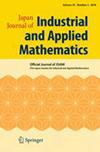双分量反应扩散系统中霍普夫-图灵-图灵奇点的不稳定性框架
IF 1.1
4区 数学
Q3 MATHEMATICS, APPLIED
Japan Journal of Industrial and Applied Mathematics
Pub Date : 2024-09-04
DOI:10.1007/s13160-024-00668-0
引用次数: 0
摘要
本文研究了具有线性扩散和局部反应项的双分量反应扩散系统中的模式形成。我们提出了一种新的不稳定性框架,其特征是双分量反应扩散系统中的 0 模式霍普夫不稳定性、(\textit{m}\)和(\textit{m}\)+ 1 模式图灵不稳定性。通过中心流形还原,我们推导出了子维度 3 分岔的正常形式,这是本文的主要成果之一。此外,我们还给出了某些反应扩散系统分岔的数值结果以及正常形式的混沌行为。本文章由计算机程序翻译,如有差异,请以英文原文为准。

An instability framework of Hopf–Turing–Turing singularity in 2-component reaction–diffusion systems
This paper investigates pattern formation in 2-component reaction–diffusion systems with linear diffusion and local reaction terms. We propose a novel instability framework characterized by 0-mode Hopf instability, \(\textit{m}\) and \(\textit{m}\) + 1 mode Turing instabilities in 2-component reaction–diffusion systems. A normal form for the codimension 3 bifurcation is derived via the center manifold reduction, representing one of the main results in this paper. Additionally, we present numerical results on the bifurcation of certain reaction–diffusion systems and on the chaotic behavior of the normal form.
求助全文
通过发布文献求助,成功后即可免费获取论文全文。
去求助
来源期刊
CiteScore
1.50
自引率
11.10%
发文量
56
审稿时长
>12 weeks
期刊介绍:
Japan Journal of Industrial and Applied Mathematics (JJIAM) is intended to provide an international forum for the expression of new ideas, as well as a site for the presentation of original research in various fields of the mathematical sciences. Consequently the most welcome types of articles are those which provide new insights into and methods for mathematical structures of various phenomena in the natural, social and industrial sciences, those which link real-world phenomena and mathematics through modeling and analysis, and those which impact the development of the mathematical sciences. The scope of the journal covers applied mathematical analysis, computational techniques and industrial mathematics.

 求助内容:
求助内容: 应助结果提醒方式:
应助结果提醒方式:


